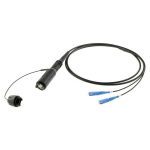Many of you may be familiar with traditional networking fibre optics but you may not be so familiar with Expanded Beam Technology.
This week I want to introduce you to a powerful system originally designed for use in harsh environments but can easily be adopted for traditional networking and OEM Product design where copper based systems struggle to carry the bandwidth required.

So what is Expanded Beam Technology? The manufacturer Radial have produce a great gide and the follow is a simple guide that tells you all you need to know!
Expanded Beam technology uses a precision lens on one mating end (connector A) to collimate and expand the emerging light beam, before a matching lens on the other mating end (connector B) refocuses the light back into the fiber core.

EB technology offers a contactless connection which increases the number of mating cycles compared to connectors based on Physical Contact technology. Due to the signal being expanded, the connection is also less sensitive to particular contamination and supports an easier cleaning process. This makes it the ideal choice for demanding applications requiring ease of maintenance in highly contaminated environments.
Lateral misalignment has less effect on transmission loss when the light beam is expanded.
Particulate contamination has less effect on transmission loss when the light beam is expanded

EXPANDED BEAM TECHNOLOGY – KEY BENEFITS:
Reliable Connection
– Contactless connection increasing operational longevity and reliability
– Less sensitivity to lateral misalignment and particulate contamination
Field Optimized Technology
– Easy cleaning
– Resistance to mechanical shock and vibration
Versatile Solution
– Compatible with MultiMode and SingleMode fibers
– Adapted to various cable configurations
– Wide range of Expanded Beam interconnect solutions
Expanded beam is a flexible solution that brings reliable optical performance in harsh environments, especially when ease of cleaning, maintenance or a high number of matings is required. If you are working at the limits of copper but worry that fibre is not robust enough then take another look with Extended Beam interconnect solutions there is really no better way to transferring massive data!!

